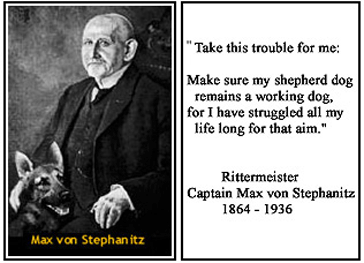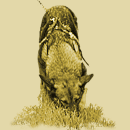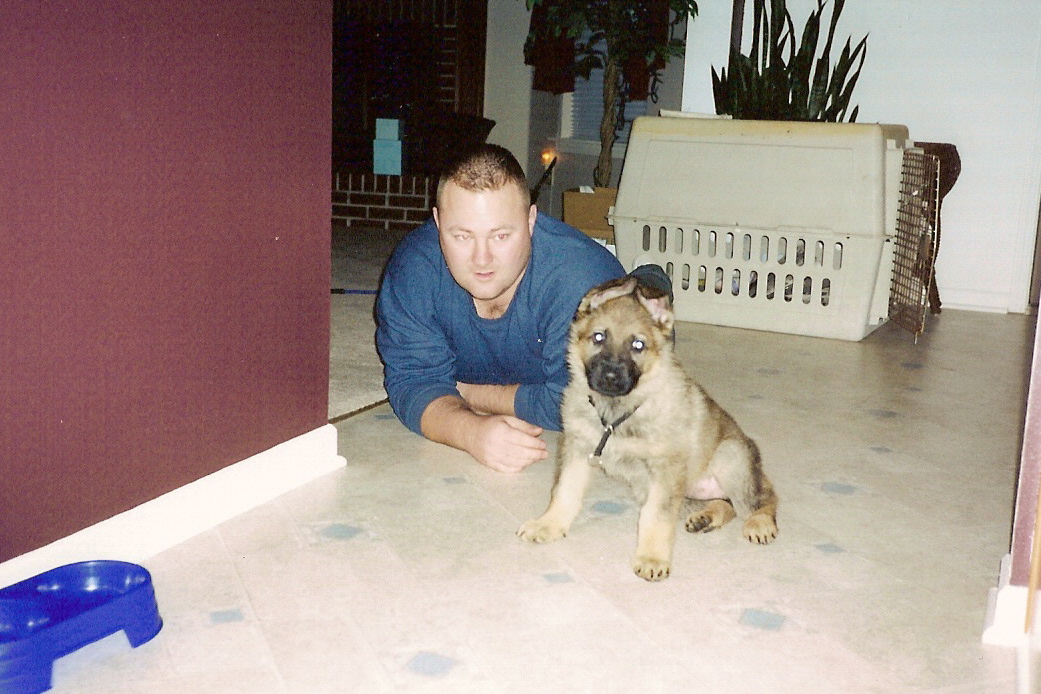Schutzhund
WHAT IS SCHUTZHUND?
Schutzhund is a German word meaning “protection dog.” It refers to a sport that focuses on developing and evaluating those traits in dogs that make them more useful and happier companions to their owners. Schutzhund work concentrates on three parts. Many familiar with the obedience work of the American Kennel Club’s affiliates will recognize the first two parts, tracking and obedience. The Schutzhund standards for the third part, protection work, are similar to those for dogs in police work. While dogs of other breeds are also admitted to Schutzhund trials, this breed evaluation test was developed specifically for the German Shepherd Dog. Schutzhund is intended to demonstrate the dog’s intelligence and utility. As a working trial, Schutzhund measures the dog’s mental stability, endurance, structural efficiencies, ability to scent, willingness to work, courage and trainability. This working dog sport offers an opportunity for dog owners to train their dog and compete with each other for recognition of both the handler’s ability to train and the dog’s ability to perform as required. It is a sport enjoyed by persons of varied professions and backgrounds, who join together in a camaraderie born of their common interest in working with their dogs. Persons of all ages and walks of life enjoy Schutzhund as a sport.
The founder of the modern day German Shepherd Dog, Captain Max von Stephanitz
The founder of the modern day German Shepherd Dog, Captain Max von Stephanitz

His book on the breed, “The German Shepherd Dog, in Word and Picture” c 1925

Schutzhund Titles
The BH (Begleithundprufung) is a degree for traffic-safe companion dogs that tests the dogs temperament in and around people. It includes basic formal obedience – heeling on and off leash, sits, downs and recalls – as well as practical tests of the dog’s character in everyday situations. These include reaction to normal situations involving crowds of people, strange noises, joggers, cars and other dogs. Before being allowed to enter for a Schutzhund I title, the dog must first have successsfully completed the BH. There are three levels of the Schutzhund test for which titles can be earned. For Schutzhund I, the dog must be at least 18 months old and pass an initial temperament test by the judge. In tracking, on a tracking line 33′ long, it must be able to follow a track laid by its handler at least 20 minutes old, navigate two corners, and indicate two articles found on the track. In the obedience, the dog must heel completely off leash including pace changes, demonstrate the walking sit, the walking down, recall, finish, group exercise, retrieve on the flat, over a hurdle, and the wall, send out and down on command, and perform a long down under distraction. In the protection phase the dog must search blinds 5 and 6, perform a bark and hold, heel out of the blind and set up for the escape, catch the escaping handler, out on command from the handler, re-attack/drive, out again. The dog then heels downfield with the handler for the courage test. After the courage test portion the dog does a side transport of the helper to the Judge. For Schutzhund II, the dog must be at least 19 months old and must already have earned its Schutzhund I degree. In tracking, the Schutzhund II candidate must be able to follow a track laid by a stranger at least 30 minutes earlier, navigate two corners, and indicate two articles. It must again pass all of the obedience required for the Schutzhund I degree, but those tests, for Schutzhund II, are made more difficult and require greater endurance, ability, and control. The dog needs to additionally perform a running down instead of a walking down, a walking stand, and the dumbell used for the hurdle and wall is a heavier weight. In the protection, the dog must run blinds 3, 4, 5, and 6. The dog must be able to be called out of the blind back to the helper after the bark and hold, and perform a rear transport and attack out of the rear transport in addition to the Schutzhund I exercises. For Schutzhund III, the master’s degree, the dog must be at least 20 months old and must have earned both the Schutzhund I and the Schutzhund II titles. Again, the tests now are made far more difficult. In the tracking the track is now aged 60 minutes and has three articles to indicate. The track also has four turns, compared with two turns for Schutzhund I and II. In the obedience there is now a running stand, and instead of returning to the dog as in the Schutzhund II the dog is recalled to the handler and finished. In the protection, the dog now searches all 6 blinds, and has additional reattacks, outs, and stick hits. The picture of obedience, strength, eagerness and confidence presented by an excellent Schutzhund III team is a beautiful illustration of what the partnership of human and dog can be! The FH1 and FH2, are advanced tracking degrees that require the dog to follow tracks at least 3 hours old over changing terrain, discriminate between cross-tracks, indicate artcles, and navigate various turns.

The Three Parts of a Schutzhund Trial
The tracking phase includes a temperament test by the overseeing judge to assure the dog’s mental soundness. When approached closely on a loose leash, the dog should not act shyly or aggressively. The track is laid earlier by a person walking normally on a natural surface such as dirt or grass. The track includes a number of turns and a number of small, man-made objects left by this person on the track itself. At the end of a 33 foot leash, the handler follows the dog, which is expected to scent the track and indicate the location of the articles, usually by lying down with it between its front paws. The tracking phase is intended to test the dog’s trainability, ability to discriminate scent, as well as, its mental and physical endurance and ability to operate in drive almost independently of the handler. The obedience phase includes a series of heeling exercises, some of which are closely in and around a group of people. During the heeling, there is a gun shot test to assure that the dog does not openly react to such sharp noises. There is also a series of field exercises in which the dog is commanded to sit, lie down and stand while the handler continues to move. From these various positions, the dog is recalled to the handler. With dumbbells of various weights, the dog is required to retrieve on a flat surface, over a one-meter hurdle and over a six-foot slanted wall. The dog is also asked to run in a straight direction from its handler on command and lie down on a second command. Finally, each dog is expected to stay in a lying down position away from its handler, despite distractions, at the other end of the obedience field, while another dog completes the above exercises. All of the obedience exercises are tests of the dog’s temperament, structural efficiencies and athleticism, drives, and very importantly, its willingness to serve it’s handler. The protection phase tests the dog’s courage, physical strength and agility. The handler’s control for the dog is absolutely essential. True power, is power under control. The exercises include a search of blinds, finding a hidden person (acting as a human decoy), and guarding that decoy while the handler then approaches. The dog is expected to pursue the decoy when an escape is attempted and to hold the grip firmly and calmly. The decoy is transported to the judge with the handler and dog walking behind and later at the decoy’s right side. When the decoy attempts to attack the handler, the dog is expected to stop the attack with a firm grip and without hesitation. The final test of courage occurs when the decoy is asked to come out of blind 6 from the opposite end of the trial field. The dog is sent after the decoy when he refuses to listen to the handler’s command to stop, continuing to advance toward the handler. The decoy then runs directly at the dog threatening the dog with a stick and yelling. The dog should powerfully and confidently engage the decoy. All grips during the protection phase are expected to be firmly placed on the padded sleeve and the dog is required to out the grip on command. The protection tests are intended to assure that the dog is neither a coward nor a criminal menace.
Horand von Grafrath, Capt. Stephanitz’ foundation dog for the German Shepherd breed

What is the Judge looking for in the Dog?

All three stages — Schutzhund I, II and III — and each of the three phases: tracking, obedience, and protection, is worth 100 points, for a total of 300 points. If a dog does not receive a minimum of 70% of the points in tracking, 70% of the points in obedience and 80% of the points in protection — or if the dog fails the pretrial temperament test —- it is not awarded a degree that day and must repeat the entire test, passing all phases of the test at a later trial. In every event, the Judge is looking for an eager, concentrating and accurate working dog. High ratings and scores are given to the animal that displays a strong willingness and ability to work for it human handler.
The Schutzhund Trained Dog in the Home
Since Schutzhund is the demonstration of the German Shepherd dog’s most desirable characteristics, dogs well trained in Schutzhund are usually excellent companions in the home. The German Shepherd Dog — like any other working dog that possesses mental stability — has trust and confidence in itself, allowing it to be at peace with its surroundings. In addition to sound structural efficiencies for long, arduous work, the standard for the German Shepherd Dog calls for mental stability and a willingness to work. The dog should be approachable, quietly standing its ground, showing confidence and a willingness to meet overtures without itself necessarily making them. It should be generally calm, but eager and alert when the situation warrants. It should be fearless under true threat, but also good with children. The German Shepherd Dog should not be timid or react nervously to unusual sounds or sights. A dog that is overly aggressive because of its overall fears of people and events can be extremely dangerous. The Schutzhund sport is designed to identify and eliminate such dogs from breeding stock. Because Schutzhund training gives the owner a great deal of control over the dog the owner is able to let the dog have more fun. Not only is Schutzhund training itself enjoyable for the dog, but the Schutzhund trained dog knows how to please its owners, creating a stronger bond between dog and owners.

Choosing a Puppy for Schutzhund
In every breed, the pedigree is the key to knowing the potential of the puppy. Schutzhund revolves around working lines — generations and generations of dogs that have proven themselves and produced similiar characteristics in their offspring. These characteristics include not only the physical structure of the dog, which is very important, but also its temperament and drive structures. Selecting the bloodlines from which you want your puppy may require advice and research. Of course, it makes sense to discuss your objectives with reputable and experienced Schutzhund handlers and breeders and get their advice. Once you have determined that the bloodlines of the potential dam and sire are of high quality, you should observe the parents, especially the mother, if that is at all possible. The dam will be the main influence on the young pup for the first six weeks of its life. If you are able to see the litter, watch the puppies, and talk to the breeder to try to determine which is the best puppy for YOU and your needs. It is important that the puppy have intense instinct to stalk the prey — a ball, a toy, etc. — and also be the leader in the sense of bullying the other puppies. The puppy should not show fear to new things or noises or when away from its littermates. It should not need to stay with the mother. The puppy should be adventurous and active, playing with or curious about objects shown to it, but it should be independent enough to take that object and go off on its own as well.
Raising a Puppy for Schutzhund Work
Puppyhood is the most critical period for the development of the characteristics you want to encourage. Your local Schutzhund club can advise you about nurturing and socializing your growing puppy. A puppy learns from it experiences, so you want to provide only positive ones. It should be provided with opportunity to explore and investigate new situations and new people, but always in a non-threatening way. Remember that your goal is to build confidence in the young animal. Your aim is NOT to dominate, startle, or oppress the young pup. Exposure to different environments is crucial to the general education of the dog and also to assure it that the world is a safe place. If something appears to make the dog unsure, give it the opportunity to investigate it slowly, but do not force the issue. It is imperative to avoid situations where your dog would be dominated by another older or stronger dog, or by another puppy. You also want to avoid having to discipline or correct your puppy and thus dampen its spirit or damage its self-confidence. You can do this by never leaving the pup in a situation where it can cause damage to your valuables or find itself in a dangerous predicament. The final area of development is that of drive encouragement. The natural behaviors that you want to encourage are playing with the ball, tug of war, hide and seek, pulling toys on a string, pursuing you rapidly when you run away, and finally defending itself, its family and its home. The latter really only shows itself between the ages of nine and eighteen months as the pup begins to mature by barking at strangers or intruders. It is better to leave for later, formal obedience training with a young dog. The character of the puppy is not sufficiently strong to withstand the corrections involved in obedience training. Acceptable manners at home and in the car and “play“ training, like learning to sit for a food reward, with NO corrections involved, is advisable. Real obedience work should begin only after the dog is well on its way in the protection training.
Schutzhund Around the World
The first Schutzhund trial was held in Germany in 1901 to emphasize the correct working temperament and ability in the German Shepherd breed. Originally, these dogs were herding dogs, but the industrialization of Germany encouraged breeders to promote the use of their dogs as police and military dogs. The Verein fur Deutsche Schaferhunde (SV), the parent club, became concerned that this would lead to careless breeding and undesirable traits such as mental instability, so it developed the Schutzhund test. Since then, many other countries and working dog organizations have also adopted Schutzhund as a sport and a test of working performance in dogs. International rules have been established, and they are administered by the Verein fur Deutsche Hundesport (VDH). In 1970, the first Schutzhund trial was held in the United States. Today, the sport of Schutzhund is sponsored in all parts of the country and sends a team in open competition to represent the United States at the WUSV World Championships. Countless countries around the globe send teams of competitors each year to the World Championships from the World Union of German Shepherd clubs to represent the sport presence in their respective countries.
Some Old Schutzhund/German Shepherd Videos
These are some old Schutzhund/German Shepherd Dog videos you might find interesting. Much different from what you see today!